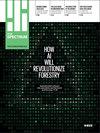Todd Austin:未来的处理器将必须获得精益
IF 2.4
4区 工程技术
Q2 ENGINEERING, ELECTRICAL & ELECTRONIC
引用次数: 0
摘要
今年7月,密歇根大学(University of Michigan)的一位计算机工程教授提出了一种衡量处理器设计效率的新方法。Todd Austin的精益度量标准既受到赞扬,也受到质疑,但即使是批评者也理解其基本原理:许多硅片被用于实际不做计算的事情。例如,超过95%的Nvidia Blackwell GPU被指定用于其他任务,Austin告诉IEEE Spectrum。这并不是说这些部件不做重要的事情,比如选择要执行的下一条指令,但是Austin认为处理器体系结构可以而且应该朝着最大化计算和最小化其他一切的设计方向发展。本文章由计算机程序翻译,如有差异,请以英文原文为准。
5 Questions: Todd Austin: Future Processors will have to get Lean
In July, a University of Michigan computer engineering professor put out a new idea for measuring the efficiency of a processor design. Todd Austin's LEAN metric received both praise and skepticism, but even the critics understood the rationale: A lot of silicon is devoted to things that are not actually doing computing. For example, more than 95 percent of an Nvidia Blackwell GPU is designated for other tasks, Austin told IEEE Spectrum. It's not like these parts aren't doing important things, such as choosing the next instruction to execute, but Austin believes processor architectures can and should move toward designs that maximize computing and minimize everything else.
求助全文
通过发布文献求助,成功后即可免费获取论文全文。
去求助
来源期刊

IEEE Spectrum
工程技术-工程:电子与电气
CiteScore
2.50
自引率
0.00%
发文量
254
审稿时长
4-8 weeks
期刊介绍:
IEEE Spectrum Magazine, the flagship publication of the IEEE, explores the development, applications and implications of new technologies. It anticipates trends in engineering, science, and technology, and provides a forum for understanding, discussion and leadership in these areas.
IEEE Spectrum is the world''s leading engineering and scientific magazine. Read by over 300,000 engineers worldwide, Spectrum provides international coverage of all technical issues and advances in computers, communications, and electronics. Written in clear, concise language for the non-specialist, Spectrum''s high editorial standards and worldwide resources ensure technical accuracy and state-of-the-art relevance.
 求助内容:
求助内容: 应助结果提醒方式:
应助结果提醒方式:


